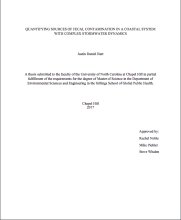
Stormwater outfalls that discharge into coastal waters have detrimental impacts on human and ecosystem health worldwide. Elevated levels of pathogenic bacteria, viruses, nutrients, sediment, and turbidity are associated with coastal stormwater outfalls, leading to swimming and fishing closures, illness, and negative impacts on estuarine ecosystems. Recent research on stormwater outfalls in North Carolina, including those discharging to the Rachel Carson Reserve (a component of North Carolina National Estuarine Research Reserve), shows dramatic delivery of contaminants during storm events. However, most decision makers and stakeholders concerned with water quality are unprepared to address long-term water quality issues related to stormwater discharge. A 2016 Collaborative Research project is conducting applied research using a multi-faceted, collaboratively-designed approach to assess stormwater impacts on the North Carolina Reserve.
About this article
This paper was written by Justin Daniel Hart, an advisee of Rachel Noble, in partial fulfillment of the requirements for the degree of Master of Science in the Department of Environmental Sciences and Engineering at the University of North Carolina at Chapel Hill. It describes a quantitative microbial assessment of stormwater in Beaufort, North Carolina that was conducted as part of a Science Collaborative Research project.
Hart, Justin D. 2017. Quantifying sources of fecal contamination in a coastal system with complex stormwater dynamics. Master's thesis, Unversity of North Carolina Chapel Hill. Available at: https://cdr.lib.unc.edu/record/uuid:d1c2b9fc-b867-4a09-862d-fb3bc0c07117